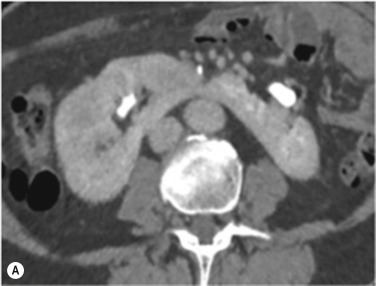Physical Address
304 North Cardinal St.
Dorchester Center, MA 02124
Detailed embryological development of the kidneys and ureters will not be described in detail. The kidney precursors initially develop in the pelvis and ascend to their normal positions lateral to the proximal lumbar spine by 8 weeks’ gestation. As ascent occurs, the kidneys also rotate 90 degrees to their normal position with the renal hila pointing medially.
If normal migration fails to occur, the kidney is located in an abnormal position and is termed ectopic. The incidence of renal ectopy is in the region of 1 in 1000. The ectopic kidney is commonly located below the pelvic brim and then is termed a pelvic kidney. An ectopic kidney is also usually malrotated, with the hilum pointing anteriorly.
When an ectopic kidney crosses the midline, this is termed crossed renal ectopy. In most of these cases (85%–90%), there will be fusion of the crossed kidney with the normally located contralateral kidney and this is termed crossed-fused ectopy. Crossed renal ectopy without fusion occurs in approximately 1 in 75,000 compared with crossed-fused renal ectopy, which is seen much more commonly in 1 in 7500.
Horseshoe kidney is the most common renal fusion anomaly and occurs in approximately 1 in 500 to 1 in 1000 births ( Fig. 28.1 ). Horseshoe kidney results from abnormal migration of both kidneys with midline fusion usually of the lower poles (90%), which then point medially. Normal renal ascent is limited by the inferior mesenteric artery. The isthmus of the horseshoe kidney is composed of a fibrous band or, more commonly, by functioning renal parenchyma (85% to 95%).

Renal agenesis may be unilateral or bilateral. In one large multicentre European study, unilateral agenesis occurred in 8 per 100,000 births and bilateral agenesis in 13 per 100,000 births. Bilateral renal agenesis is associated with multiple complications, including oligohydramnios and the Potter sequence, and until recently was regarded as a fatal diagnosis. Unilateral agenesis may be asymptomatic but may also be associated with renal and extra-renal anomalies such as VACTERL association; vesicoureteric reflux; hypertension; and cardiac, genital (müllerian duct anomalies, seminal vesicle cysts), gastrointestinal and respiratory anomalies; trisomy 21 and 22 and Turner syndrome; skeletal anomalies (clubfeet); and adrenal agenesis.
Renal hypoplasia is characterised by small kidneys with a decreased number of nephrons and is thought to be due to renal developmental arrest during the first trimester of gestation. Imaging features include decreased kidney size and sometimes hyperechoic, cystic kidneys.
A calyceal diverticulum is a congenital diverticulum from the renal pelvis into the renal cortex. Most are asymptomatic and found incidentally on imaging for another indication. Possible complications leading to symptoms include development of calculi and obstruction and/or recurrent infections. These may lead to presentation with flank pain and haematuria.
Become a Clinical Tree membership for Full access and enjoy Unlimited articles
If you are a member. Log in here